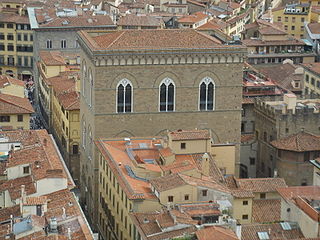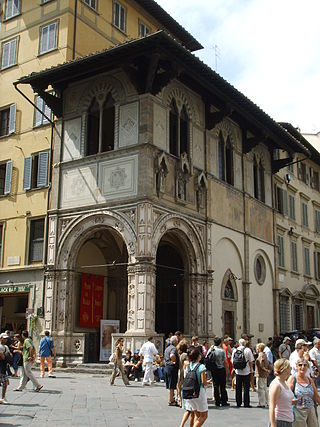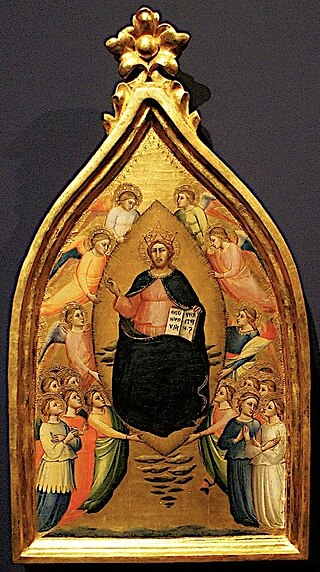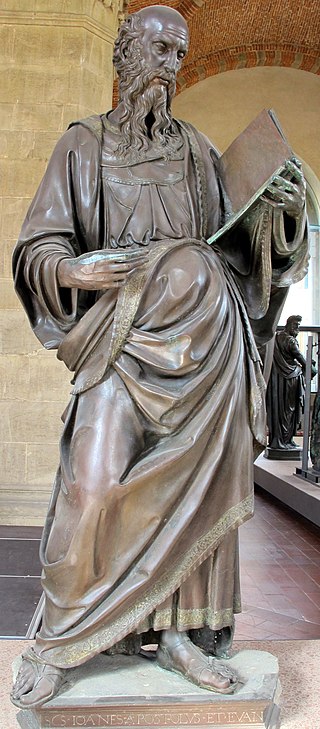
Andrea di Cione di Arcangelo, better known as Orcagna, was an Italian painter, sculptor, and architect active in Florence. He worked as a consultant at the Florence Cathedral and supervised the construction of the façade at the Orvieto Cathedral. His Strozzi Altarpiece (1354–57) is noted as defining a new role for Christ as a source of Catholic doctrine and papal authority.

Orsanmichele is a church in the Italian city of Florence. The building was constructed on the site of the kitchen garden of the monastery of San Michele which no longer exists.

Giovanni di Antonio di Banco, called Nanni di Banco, was an Italian Renaissance sculptor from Florence. He was a contemporary of Donatello – both are first recorded as sculptors in the accounts of the Florence Duomo in 1406, presumably as young masters.

The Bargello, also known as the Palazzo del Bargello or Palazzo del Popolo, is a former public building and police headquarters, later a prison, in Florence, Italy. Mostly built in the 13th century, since 1865 it has housed the Museo Nazionale del Bargello, a national art museum.
Donatello's Saint Mark (1411–1413) is a marble statue that stands approximately 7 ft 9 in (2.36 m) high and is displayed in the museum of the Orsanmichele church, Florence. It originally was displayed in an exterior niche of the church, where a copy now stands. It depicts Mark the Evangelist.

The Arte della Lana was the wool guild of Florence during the Late Middle Ages and in the Renaissance. It was one of the seven Arti Maggiori ("greater trades") of Florence, separate from the Arti Minori and the Arti Mediane (the "middle trades"). The Arte della Lana dealt in woollen cloth and cooperated with the other corporations of bankers and merchants in administering the commune, both under the podestà and the Republic of Florence. The powerful Albizzi family were prominent members of the guild.

Christ and Saint Thomas (1467–1483) is a bronze statue by Andrea del Verrocchio made for one of the fourteen niches on the exterior walls of the Orsanmichele in Florence, Italy. It is now replaced in that location by a cast and the original has been moved inside the building, which is now a museum. The sculpture shows the Incredulity of Saint Thomas, a subject frequently represented in Christian art since at least the 5th century and used to make a variety of theological points. Thomas the Apostle doubted the resurrection of Jesus and had to feel the wounds for himself in order to be convinced. The surrounding marble niche was originally designed by Donatello for his Saint Louis of Toulouse (1413), but that statue was moved to Santa Croce when the niche was sold to the Tribunale di Mercanzia, who commissioned the replacement from Verrocchio.

The Loggia del Bigallo is a late Gothic building in Florence, region of Tuscany, Italy. It stands at the corner of Piazza San Giovanni and via Calzaioli; tradition holds the site near the Baptistry of Florence was donated by a benefactor.

Niccolò di Piero Lamberti, also known as Niccolò di Pietro Lamberti, Niccolo Aretino, Niccolò d'Arezzo and il Pela, was an Italian Renaissance sculptor and architect. Little is known about his life other than that he was married in Florence in 1392. His son, Piero di Niccolò Lamberti (1393–1435), was also a sculptor, and the two are notable for exporting the Tuscan style of sculpture to Venice, where they were active in the late 1410s and 1420s.

The Barbadori Altarpiece is a polyptych painting by Filippo Lippi, commissioned in 1437 and completed in 1438. It consists of a main panel followed by a predella. The main panel, Virgin and Child Surrounded by Angels with St. Frediano and St. Augustine, is a sacra conversazione that contains flow between each figure to depict a coronation.

The Tabernacle of the Linaioli is a marble aedicula designed by Lorenzo Ghiberti, with paintings by Fra Angelico, dating to 1432–1433. It is housed in the National Museum of San Marco, Florence, Italy.

Mariotto di Nardo di Cione was a Florentine painter in the Florentine Gothic style. He worked at the Duomo of Florence, the church of Santa Maria Maggiore, and the Orsanmichele. He created both frescoes and panel paintings, and was also active as a manuscript illuminator.

The Palazzo dell'Arte dei Beccai or Residenza dell'Arte dei Beccai is a fourteenth-century building in Florence, Italy. It faces the Orsanmichele, once a grain market, later the church of the guilds of Florence. It has had many occupants, including the Arte dei Beccai or guild of butchers from which its name derives. Since 1974 it has housed the Accademia Fiorentina delle Arti del Disegno, an academy of the arts.

Saint George is a marble sculpture by Donatello. It is one of fourteen sculptures commissioned by the guilds of Florence to decorate the external niches of the Orsanmichele church. St. George was commissioned by the guild of the armorers and sword makers, the Arte dei Corazzai e Spadai.

The Madonna of the Rose is a 2.2 metre high marble sculpture of the Madonna and Child enthroned, with the Child trying to take a bunch of rosa canina from his mother's hand. It forms part of a cycle of fourteen sculptures of the patron saints of the guilds of Florence on the external niches of the Orsanmichele church. No documents survive to precisely date it, leading to several theories and attributions. Most art historians attribute it to Pietro di Giovanni Tedesco, a German or Flemish sculptor active in Florence in the sculpture-yard of Florence Cathedral. It shows similarities to late works from the school of Giotto.

Saint John the Evangelist is a 2.66 m high bronze statue of John the Evangelist by Baccio da Montelupo, completed in 1515. It was commissioned by the Arte della Seta as part of a cycle of fourteen sculptures for the external niches of Orsanmichele, each showing the patron saint of one of the guilds of Florence. It is now in the Museo di Orsanmichele, although a replica fills its original niche.

Saint Luke is a 2.73 m high bronze statue of Luke the Evangelist by Giambologna, commissioned by the Arte dei Giudici e Notai and completed in 1597–1602. One of a cycle of fourteen commissioned by the guilds of Florence for the external niches of Orsanmichele, it is now in the Museo di Orsanmichele, although a replica fills its original niche.
Saint Peter is a Apuan marble sculpture of Saint Peter of 2.43 m high. It is attributed to Filippo Brunelleschi and his style is influenced by Donatello. It forms part of a cycle of fourteen statues of the patron saints of the guilds of Florence for the external niches of Orsanmichele. The sculpture of St Peter was completed for the Arte dei Beccai (butchers) guild around 1412 and is now in the Museo di Orsanmichele, although a replica fills its original niche.

Saint Louis of Toulouse is a gilded bronze sculpture of Louis of Toulouse by Donatello with a marble niche all'antica on the facade of Orsanmichele, executed in 1423–1425. It is now in the refectory of the Museo di Santa Croce in Florence.

Adoration of the Magi is a c.1522-1523 oil on panel painting by Pontormo, produced for the antechamber of Giovan Maria Benitendi's palazzo in Florence and now in the Galleria Palatina in the same city.


















